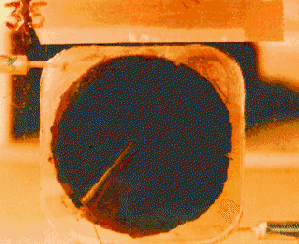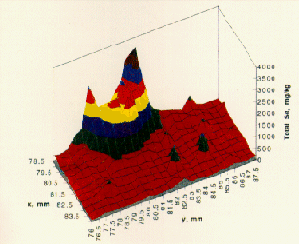

Tetsu Tokunaga, of the Earth Sciences Division, is using two techniques, x-ray absorption spectroscopy (XAS) and synchrotron x-ray fluorescence microprobe mapping (SXRFM), to study selenium-contaminated soils from the Kesterson Reservoir and Wildlife Refuge in the San Joaquin Valley. His early work has demonstrated that both techniques show great promise for helping future environmental cleanup operations.
The XAS technique provided the first direct evidence for the presence of elemental selenium at Kesterson -- which is good news for wildlife, because this insoluble form of selenium is not likely to be transported from the soil into the water. The SXRFM technique demonstrated that the distribution of selenium in contaminated soil is not uniform. In water-saturated soil immediately adjacent to decomposing plant roots, the concentration of selenium was found to be 20 times greater than in the surrounding soil. This selenium enrichment helps explains some puzzling observations made at Kesterson monitoring sites.
Selenium is a naturally occurring, potentially toxic trace element that became an issue of great public concern in California in the early 1980s with the poisonings and deaths of wild birds at the Kesterson Reservoir. Subsequent analysis indicated that selenium in agriculture drainage water was responsible. Ever since, Tokunaga and some two dozen other LBL researchers have been learning how to control selenium contamination.
Tokunaga applied XAS to the Kesterson soils after others proved the technique is effective for obtaining information on trace elements in pure mineral specimens. Collaborating with Gordon Brown, Ingrid Pickering, and others at Stanford Synchrotron Radiation Laboratory, he demonstrated that not only does XAS provide quick, accurate and detailed measurements of selenium speciation, it does so without the elaborate extraction procedures required of conventional analytic methods that may alter the chemical form of the selenium being measured.
For his SXRFM studies, Tokunaga and collaborator Stephen Sutton used beams from the National Synchrotron Light Source at the Brookhaven National Laboratory. With this technique he was able to map the distribution of selenium throughout a soil sample and show that the fate of this contaminant is linked to heterogeneously distributed microbial activity, such as the decomposition of plant material.
The brighter, more sharply focused x-ray beams of the ALS will enable Tokunaga to expand his research from selenium to other major soil contaminants, such as boron.